Long Posts
- I want to be a loving and mostly gentle mother.
- I want to take care of my own body, including making clothes built to fit it.
- I want to keep trying new things and growing as a self-employed person.
- I want to be aware of my impact on the earth and do what I can to make it gentle.
- United States
- The Netherlands
- Germany
- Scotland
- Ireland
- England
- France
- Arizona
- California
- Florida
- Georgia
- Kentucky
- Louisiana
- Maryland
- New York
- North Carolina
- Ohio
- Pennsylvania
- South Carolina
- Tennessee
- Virginia
- The Original Influencer Was French—A Show Dedicated to Sarah Bernhardt Celebrates the World’s First Superstar
- Why Actress Sarah Bernhardt Was the First Modern Celebrity
- Before Taylor Swift or David Bowie, There Was Sarah Bernhardt
- Read what other people have written, especially keeping an eye out for interesting questions that I might want to anwer. What do I read? Whatever seems interesting.
- Do interesting things that aren’t work.
- Sit in the sun and think.
📚 Books about Freelance Writing
Originally posted on LinkedIn:
One of the tools in my toolbox for carrying me through times between big projects is freelance writing. As I expect to ramp this piece of my work up when my current contract (which is full-time work) ends, I’ve been revisiting my resources to help me with this.
Here are 3 books I use for this:
📕 The Freelance Academic by Katie Rose Guest Pryal
📗 How to Get Started in Freelance Science Writing by Sheeva Azma
📘 Win at Freelance Writing by Gertrude Nonterah, Ph.D.
What are your favorite resources?

LinkedIn introduction
I’ve been experimenting with posting on LinkedIn more frequently and while some of my posts there are posted at my domain first, others are specific to LinkedIn. But in the interest of owning my data (unlike Starfleet, who does not own Data), I thought I’d repost those here at my site.
Originally posted on LinkedIn:
Hi there!
I have a lot of new followers, so I thought it’d be a good time for an introduction post.
👋🏻True things about my life that shape my work: I’m a mom of an almost-7-year-old. I live with multiple chronic illnesses. I’m the daughter of parents who have multiple chronic illnesses between them.
💗 Work that lights me up: facilitating learning, either for young people or adults who work with them, and fostering creativity (for anybody).
📆 My perpetual 5 year plan: do work that’s interesting and important. Right now, that’s research to help library staff leverage youth interests for relationship-building and creating academic, civic, and professional opportunities for youth.
◀️ Previously, on Kimberly’s work: blogging about qualitative research methods, researching how cosplayers interact with information, making university makerspaces more inclusive, training librarians and educators on racial equity, leading university outreach to K-12 educators, being librarian for middle schoolers, teaching Latin.
❓ What’s next? Hoping to be lower school librarian at my kid’s school, so I’m refreshing my knowledge on collection management and ed tech. Continuing to freelance for businesses interested in qual research, K-12 outreach, and making the Internet better.
🛝 For fun: Always reading (on a romance tear since May), playing video games, especially couch co-op with my kid & spouse. In pre-kid & pre-pandemic times, community theater and improv.
🫵🏻 Your turn! What should I know about you?
I might not eat this whole baguette today.
When we stayed in Le Vésinet, a suburb of Paris, there was a boulangerie on our walk home from the train station. Every time we went into the city, we would stop there and grab a baguette (and usually some other things, too) to have back at the house. I recently got homesick for Paris and found Sophie Nadeau’s blog post, Here’s How to Recreate the Paris Experience in Your Home.
This morning, in order to follow her recommendation to eat a typical French breakfast, I went to Guglhupf, which makes excellent baguettes (but is technically a German bakery) and bought 2.
I don’t know if I’ll polish one off today or not.
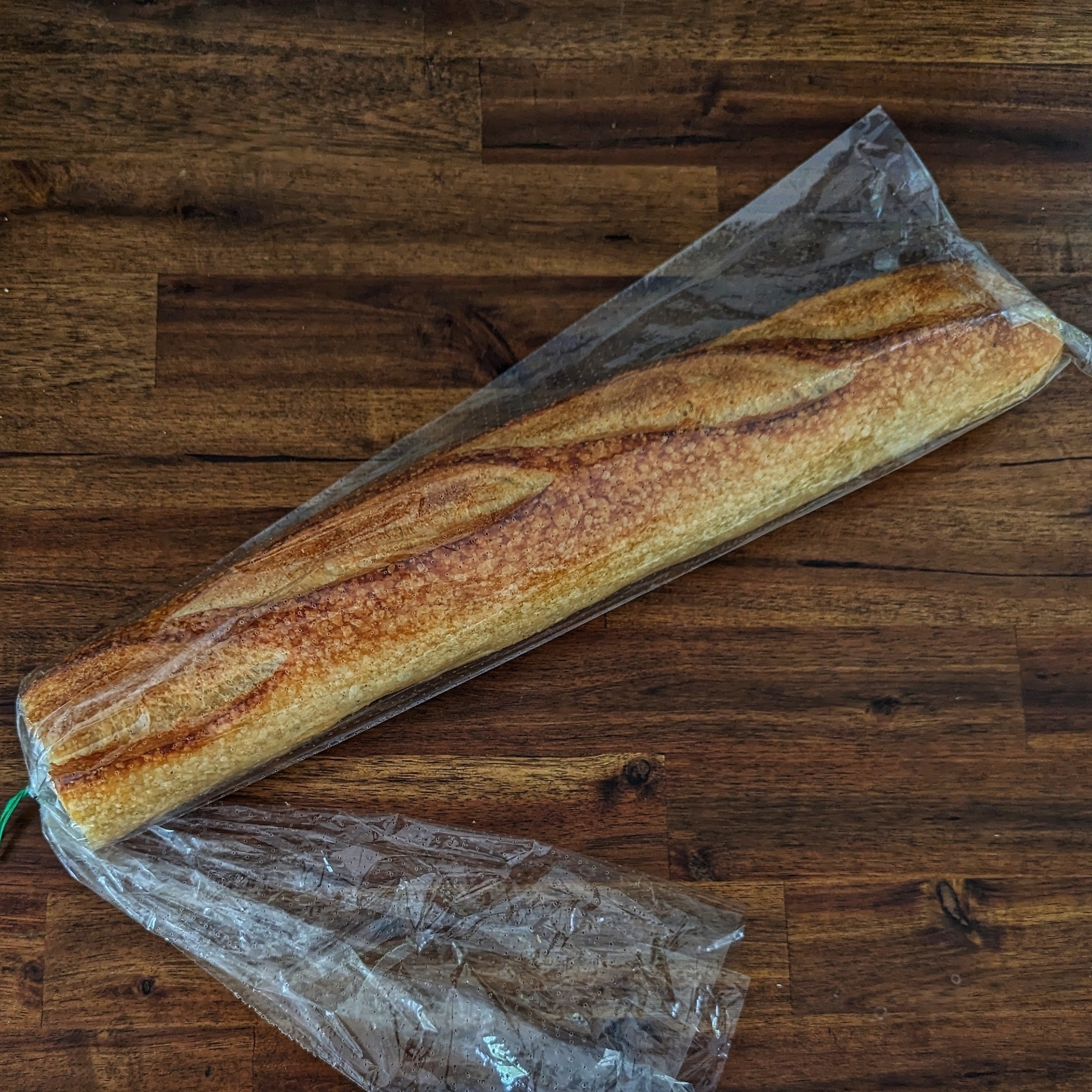
Farewell, Wednesday. 🐈⬛💔
CW: Pet death
When we brought our kitties home last week, Wednesday had a little nasal discharge. The person at the front desk was all, “Yeah, that’s an upper respiratory infection, they’re super common in shelters, just get her to the vet and they’ll give you some antibiotics.”
I couldn’t get her into the vet until Monday. By Monday, she had lost a third of her bodyweight. She was severely dehydrated. She was constipated. The vets gave me a bunch of (not inexpensive) meds and gave her subcutaneous fluids. Later in the day, I got the discharge notes and they said I should bring her back the next day for more fluids if she didn’t improve in the night.
I took her back, they gave her fluids, and I asked if we could give her fluids at home. They said yes, told me what to do to feed her from a syringe (it’s called trickle feeding), and told me they didn’t know if she was going to make it.
Yesterday, W’s mom came over and we gave her fluids twice. I fed her with a syringe every two or three hours. I gave her all her meds.
This morning, M went in to check on the kittens and when I went in, I saw that she had died in the night.
This is, of course, very sad. But it’s also something I’ve been prepared for for a few days. I know I did everything I could for her. I also know, especially after consulting with the vet when I took her for fluids a couple day ago, that the shelter did wrong by her by not only not treating the respiratory infection but also by going ahead and giving her a bunch of vaccines and spaying her while she was sick.
I know the shelter is struggling, too, so I’m not angry.
But damn. What a set of events to conspire against a little kitten.
I only knew her a little and her personality faded as she got sicker, but she was a fierce, adventurous girl.
On the other hand, her brother Midnight, who also came home with an upper respiratory infection but much less severe, is thriving. We’ll be giving him lots of love and attention.
On twenty-five years of being together
Twenty-five years ago tonight, W. and I went on our first date. (Yes, we were young.) We went to see a cross-cast production of A Midsummer Night’s Dream. Afterward, we went to Ben and Jerry’s.

I was going to catalog a bunch of memories of those early days together here, but I think I want to keep them in my heart. And, of course, as heady as that first rush of falling in love is, it’s the time after it that builds to an anniversary this big.
It feels like and is a long time, 25 years. It’s wild because it doesn’t seem to me that we’ve been together that long because how could I still find someone so incredibly delightful after all that time? How is it that every pun he makes still cracks me up? That the way he moves through the world, like literally physically carries himself, can still bring a flush to my cheeks? What miracle is this, to get to spend this much time with someone so great?
It’s a choice every day to wake up and keep loving each other. To show up, to have patience when we’re not on the same page. To know that even when we’re not on the same page, we’re on the same team. And it’s a blessing, a gift from whomever gives us cosmic gifts, to have the chance to make that daily choice.
We’re celebrating a quarter century by taking M. to the animal shelter to pick out two kittens to add to our family.
Bookstore Romance Day Recommendations 📚♥️
We’re just a few days out from Bookstore Romance Day!
A couple things to know about romance novels:
First, they always end with the love interests having either a happily ever after or a happy for now.
Second, they range in smuttiness from super sweet with hardly any physical intimacy, to quite explicit. But the emotions are always the core of the story, not the smut.
Here are some of my favorite romance reads. Pick some up at your favorite indie bookstore!
Mr. and Mrs. Witch by Gwenda Bond. Like Mr. & Mrs. Smith but with a lady witch and her dude witch hunter fiance. World travel, intrigue, blisteringly hot.
The Widow of Rose House by Diana Biller. Gilded Age, haunted house, widow unfairly subjected to scandal, cute inventor man, fairly steamy.
Ayesha at Last by Uzma Jalaluddin. Pride & Prejudice but everyone lives in Toronto, is Muslim, and is Indian or Indian-Canadian. Sweet, not even kisses until close to the end.
Hana Khan Carries On by Uzma Jalaluddin. You’ve Got Mail but with halal restaurants instead of bookstores. Everyone lives in Toronto, is Muslim, and is Indian or Indian-Canadian. Sweet, not even kisses until close to the end.
Red, White, & Royal Blue by Casey McQuiston. Transatlantic shenanigans where the son of the president of the US hates and then loves the spare prince of England. Very hot, a little explicit but not much, super witty, unputdownable. Read if you watched the movie but wanted more. (Skip the movie if you read it and will be disappointed that they had to combine or change characters and drop a lot of detail to make it work for the screen.)
The Neighbor Favor by Kristina Forrest. A publishing assistant corresponds with her favorite author, who stopped writing fiction after his book about black elves didn’t sell much and his publisher closed. He ends up being her neighbor and they fall in love. Pretty steamy.
If you’re more of an audiobook person, see if you can support your local indie bookstore via Libro.fm.
📚 Research methods in Emily Wilde's Encyclopedia of Faeries by Heather Fawcett
📚 I am a very specific kind of nerd. In this book, set in 1909, a scholar studying faeries says she’s going to use naturalistic observation and ethnographic interviews as her research methods. I immediately thought this was anachronistic, because I knew Naturalistic Inquiry wasn’t published until 1985.
I was wrong. It’s not anachronistic, but it does show that Dr. Wilde is using cutting edge methods. While ethnography was first developed as a science in the 18th century, naturalistic observation wasn’t formalized until the turn of the 20th century.
So. Who cares? Well, me, because I’m a qual nerd. But I’m also a book nerd, so I feel like Wilde’s choice of methods reveals something about her as a character.
The way she writes about her research shows that she thinks of herself as a natural scientist, observing faerie behavior much as one would observe animal behavior. At the same time, the questions she’s asking and the way she treats her research “subjects” (a term that isn’t cool to use now but is absolutely what you’d use in 1909) shows that she can’t help but treat her research as social research, because surprise! in her world, faeries are people, not animals.
(What distinguishes people from animals? I’d say for Wilde’s purposes, speech and self-awareness.)
And now that I’ve written 200+ words about an imaginary scientist’s research methods, I should probably get back to bed.

📚 Finding my throughline: Library enthusiast 💻
I recently listened to Katie Rose Guest Pryal on Camille Pagán’s podcast, You Should Write a Book, talking about how she found the throughline in her work and life. (Just listen to her articulate it on the podcast. I am afraid if I try to sum it up, I’ll get it wrong.)
At the time I listened to it, I was like, “I don’t know what mine is. Maybe I’ll never find it. Waaaah!”
But as I sat and let the idea marinate for a while, and I think I’ve figured it out.
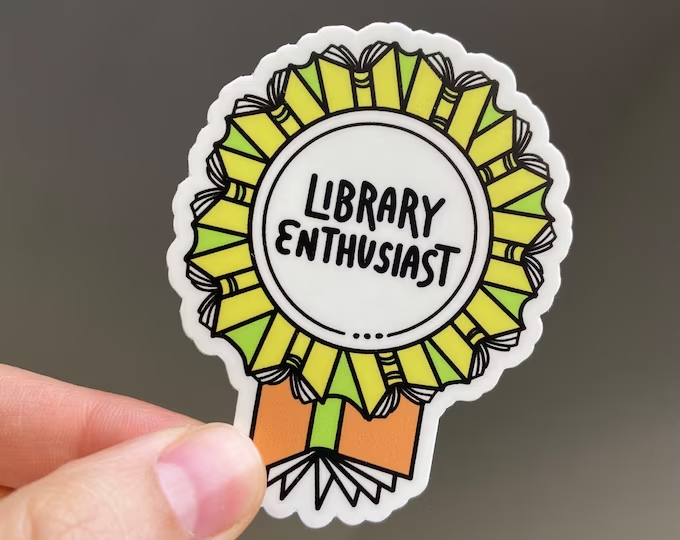
I recently bought the above sticker and several other library-themed stickers, as well as a Read Free or Die t-shirt, from its creator.
One of the possibilities I was considering for after my postdoc was going back to being a school librarian. I don’t think that one’s going to pan out, but it did sort of launch me in the direction of identifying my throughline.
In May, several folks working on different grants funded by the Institute for Museum and Library Services, including myself, met and talked about what we’d learned from our work and what our capacity was for working on connected learning in libraries moving forward. All of the other academics indicated that they had to move on to other work, which might incorporate connected learning, but would not focus on it.
I found myself heartbroken.
This is what I want to work on. And nobody else, nobody with an institutional affiliation, was going to be able to work on it anymore?
Well.
Over the course of many weeks, I decided that I would still work on it. That I would find institutional partners who were willing to do a little bit of the work, so that I don’t have to have an institutional affiliation myself to get the work funded, but that I would be happy to do the bulk of the work so long as I could get a consultant’s fee for doing it. Enough to pay my student loans, mostly.
I’m in the process of refining this vision.
But the throughline, I’ve got that now.
Fine, it needs refinement, too, but here’s the basic idea:
My work builds libraries' capacity to facilitate learning and connect with their communities. The two modes I use to do this are research and professional development.
This describes so much of what I’ve done for the past 8 years. And more than that, it describes what I want to do going forward. It’s expansive enough for me to take on a variety of projects, and narrow enough that I can continue to establish my areas of expertise and grow my network.
What’s your throughline?
C'est mon anniversaire!
It’s my birthday!
As I’m 42, I understand that according to Douglas Adams, I myself am the answer to life, the universe, and everything. (I am the one I’ve been waiting for all of my life.)
The person I wanted to be at 40 is the person I wanted to be at 41 is the person I want to be at 42:
Belated Travel Blog: Into Amsterdam for the First Time
Our first foray into Amsterdam besides going to the airport was heading to the International Newcomers office at the World Trade Center (right by the Amsterdam Zuid train station) for our immigration documents. We didn’t really see much of the city that day BUT!
We did decide to first go to Van Stapele Koekmakerij and pick up some of their cookies, which are so good and so famous that they have a line waiting every day and when they run out of cookies, they close. (Think Magnolia Bakery circa 2009.) We ordered ours in advance. You go to their shop which is in between Singel and Spui, ring a doorbell, and a very kind person squeezes out past the crowd waiting in the shop and through the doorway and asks for your order number. Then they bring out your order, packaged in either a cute box or beautiful tin and slipped in a lovely bag. It’s best to eat the cookies right away, as they’re filled with a cream that is best eaten warm and gooey. (Big thanks to Jonathan Stephens, who gave us this recommendation when my friend Whitney asked him for suggestions of things to do with a kid in Amsterdam.)

Going to Van Stapele allows you to get a lovely glimpse of the Amsterdam you think of Amsterdam as being, if you have any expectations of Amsterdam at all. You climb up the stairs from the Rokin metro station and spread before you are rows of 5 story, narrow houses all smushed together along a canal’s edge, curving toward the horizon. It’s not the most touristy part of Amsterdam, but it’s touristy-adjacent. There are plenty of “coffee shops” (like if you had to consume the marijuana you get at a dispensary before you actually leave) and the smell of Amsterdam, i.e., a scent that will give you a contact high, greets you wafting out from at least a couple of doors on every block. (It was almost weird to not smell this anymore once we left Amsterdam.)

Then we did head to IN Amsterdam and that was… not the most interesting process.
Did we do all that on the same day? Now I’m not even sure. We were planning to. I think that’s what happened.
Our next time in the city was when my sister M.E. and I took M. to Nemo Science Museum, also recommended by Jonathan Stephens and every list of kids’ activities in Amsterdam ever. This was fun, with giant gorgeous rainbow twirlers hanging down from the ceiling and an incredible chain reaction demonstration that was like a giant Rube Goldberg machine. The person running this demonstration took a quick poll of the audience to determine how many English speakers were there. As there weren’t many of us, he conducted most of his demonstration in Dutch, which gave us a chance to practice the little bit of Dutch we managed to learn in the months before we traveled. M. loved this. The museum had other interesting exhibits, including a makerspace and an area dedicated to human sexuality.
There were a lot of transit strikes while we were in the area, and we could never be sure if the bus running from Aalsmeer to Amsterdam would be running at a particular time during the strikes, so on those days we tended to just stick to places that were walkable from the house.
Next time: a Valentine’s Day date in Amsterdam!
Belated Travel Blog: Aalsmeer
I loved Amsterdam almost immediately, at first because of how the major roads are laid out. Buses have their own two lanes, totally separate from the car lanes, and then bikes have their own lanes, too. This isn’t true on the smaller roads, but it is on the big major arteries. We got off the plane and managed to figure out the trains eventually (at first I didn’t understand how tapping in and out worked, so I had to work that out but I got it eventually) and while having the luggage on the bus was stressful, it was otherwise a perfectly pleasant bus ride. The house was not as close to the bus stop as I expected, I think because when the bus route changed, they probably changed which stop they used. But that was still fine, and a cat greeted us as we turned down Seringenstraat. (Van Cleeffkade was the big road nearby where the bus stop was.)
The cat walked us all the way home to Weteringstraat 6, and we also saw a lot of adorably painted bricks on the sidewalk. It seems that these were painted by students at the primary school nearby. (Education attendance law is super different in Amsterdam than the US. I think it’s compulsory from age 4+, and we got a scary letter just a couple of weeks before we were planning to leave Amsterdam asking us to share the information about where we had enrolled Michael at school. But we hadn’t. But based on my poking around it seemed that if he was enrolled in a school in the US, which he was, then it wouldn’t be a problem. So we told them that he was, and we didn’t hear from them anymore.)
We were one block from a canal. The canals are the other thing that made me fall in love with Amsterdam. So much water! It’s funny to think that I was positively indifferent toward Amsterdam when Will decided that’s the school he was going to ask to sponsor him for the Fulbright, versus how much I came to love it once we were there. (And funnier still that as much as I loved it, I loved almost each place we came to after it more.)
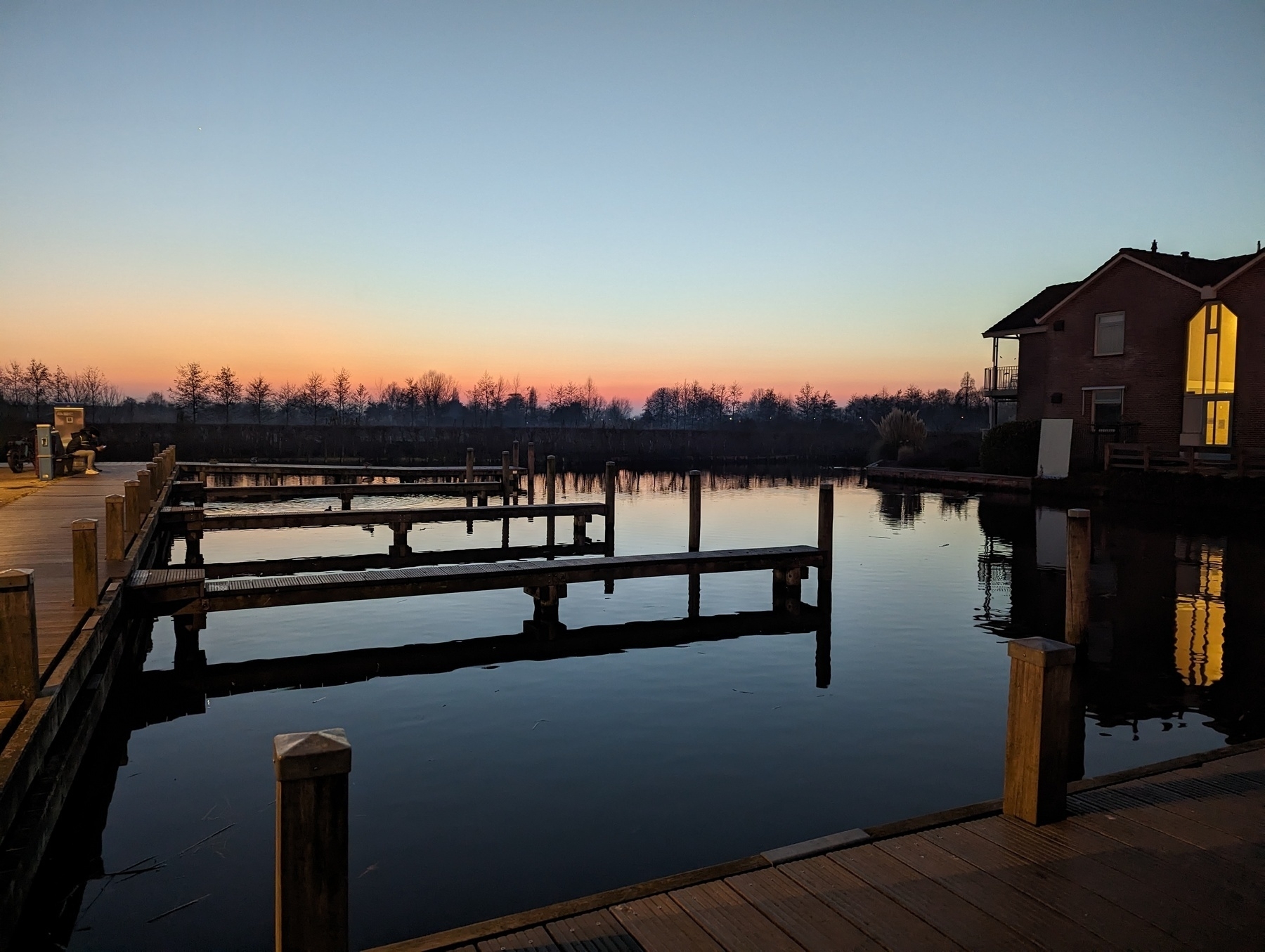
The house at Weteringstraat 6 is a townhouse with a narrow staircase, 3 bedrooms (one teeny tiny and not unlike a walk-in closet), a lovely patio, a big kitchen with eating area, and a nice living room. The living room fireplace was plugged up and the TV sat in front of it.
One of the big things about visiting lots of different houses in the course of a few months (I believe we stayed in 7 total, including our short trip to Cologne) is that you have to re-learn how to use the appliances everywhere, and of course if you’re in a country where English isn’t the official language, you better hope the Google Translate on your phone can help you figure out what the text on the appliance says. (What a blessing Google Translate is, though!)
Weteringstraat 6 is two blocks away from an Albert Heijn grocery store, likewise to a drug store (Kruidvat) and a department store (HEMA), also near a discount store called Action that felt sort of like a Dollar Tree or Big Lots without the furniture, a little farther from LIDL, around the corner from an Indonesian/Indian restaurant, and about half a block away from a chocolate shop. There were a lot of other businesses and shops nearby, but those are the ones we tended to frequent.
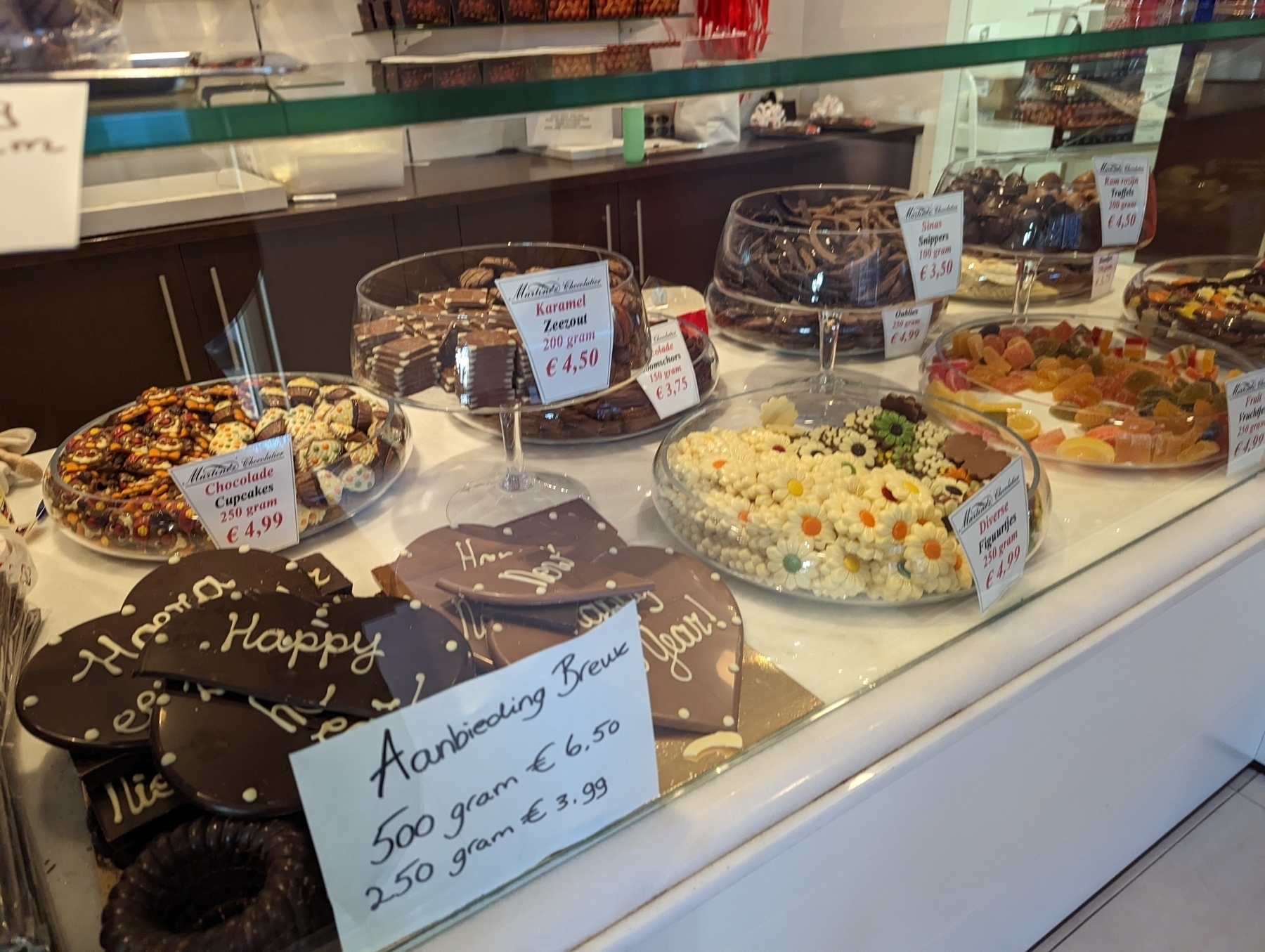
We were also a short walk away from a working windmill, which we toured. We went all the way to the top and got to see the mill working and the windmill’s wings or sails outside.
The nearest playground was clearly for toddlers and Michael found it disappointing. There were a couple of better playgrounds for him, but they were a 20+ minute walk away. One was in a little neighborhood and the other was on the shore of the Westeindeplassen, a lake, at a little spot called Surfeiland. There was also a cute little greenway nearby and we could stand on a bridge there and watch ducks swim along the canal. There’s a watertoren (Water tower) on the Westeindeplassen that was really cool, but we never went inside. There’s an escape room inside it but you have to climb the 200ish stairs to play. The top wasn’t even open because of some birds that lay their eggs there. Peregrine falcons, that’s what it was.
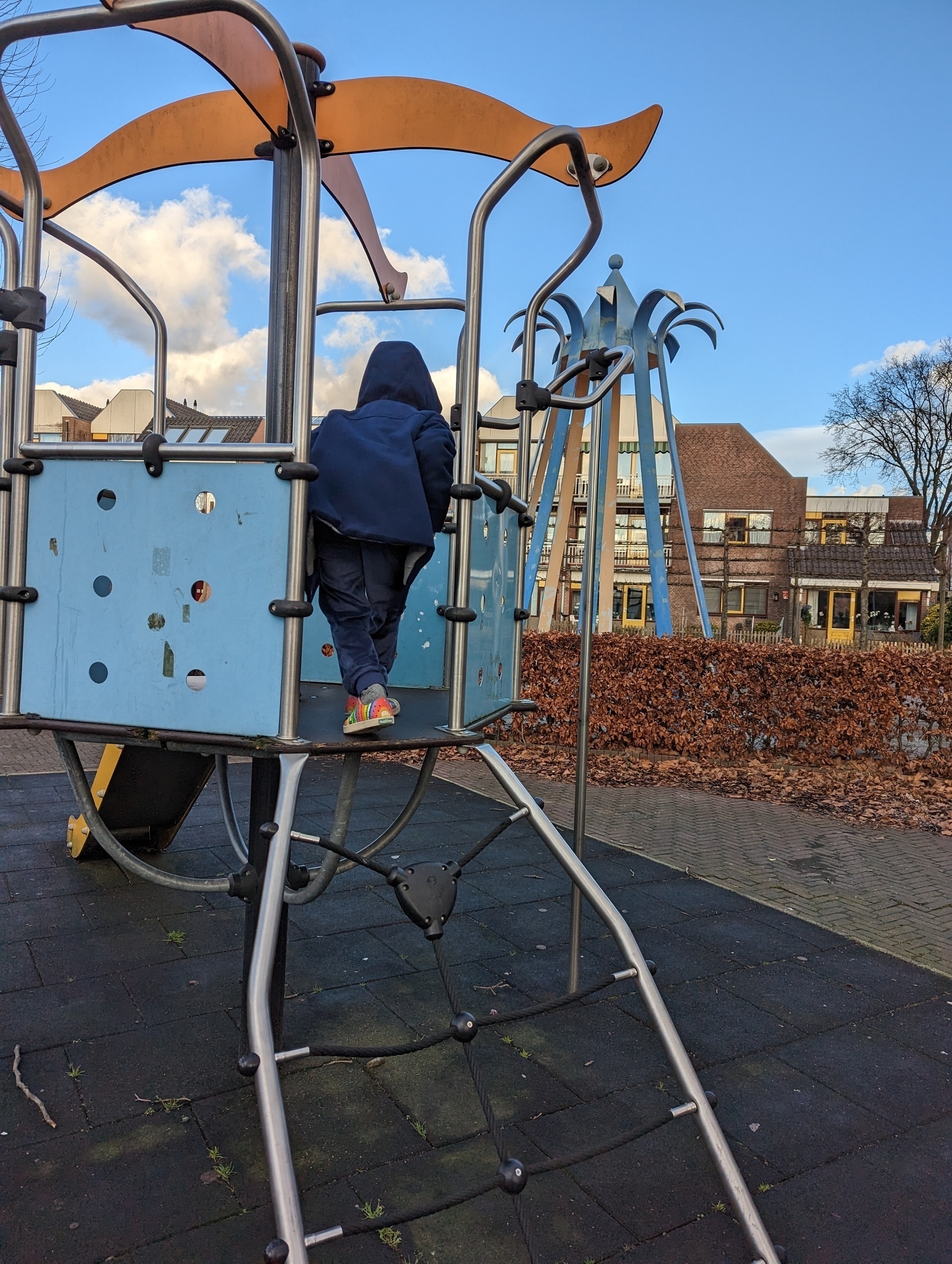


Every time we went for a walk in Aalsmeer, we seemed to run into at least three cats. I made a zine about the cats of Aalsmeer.
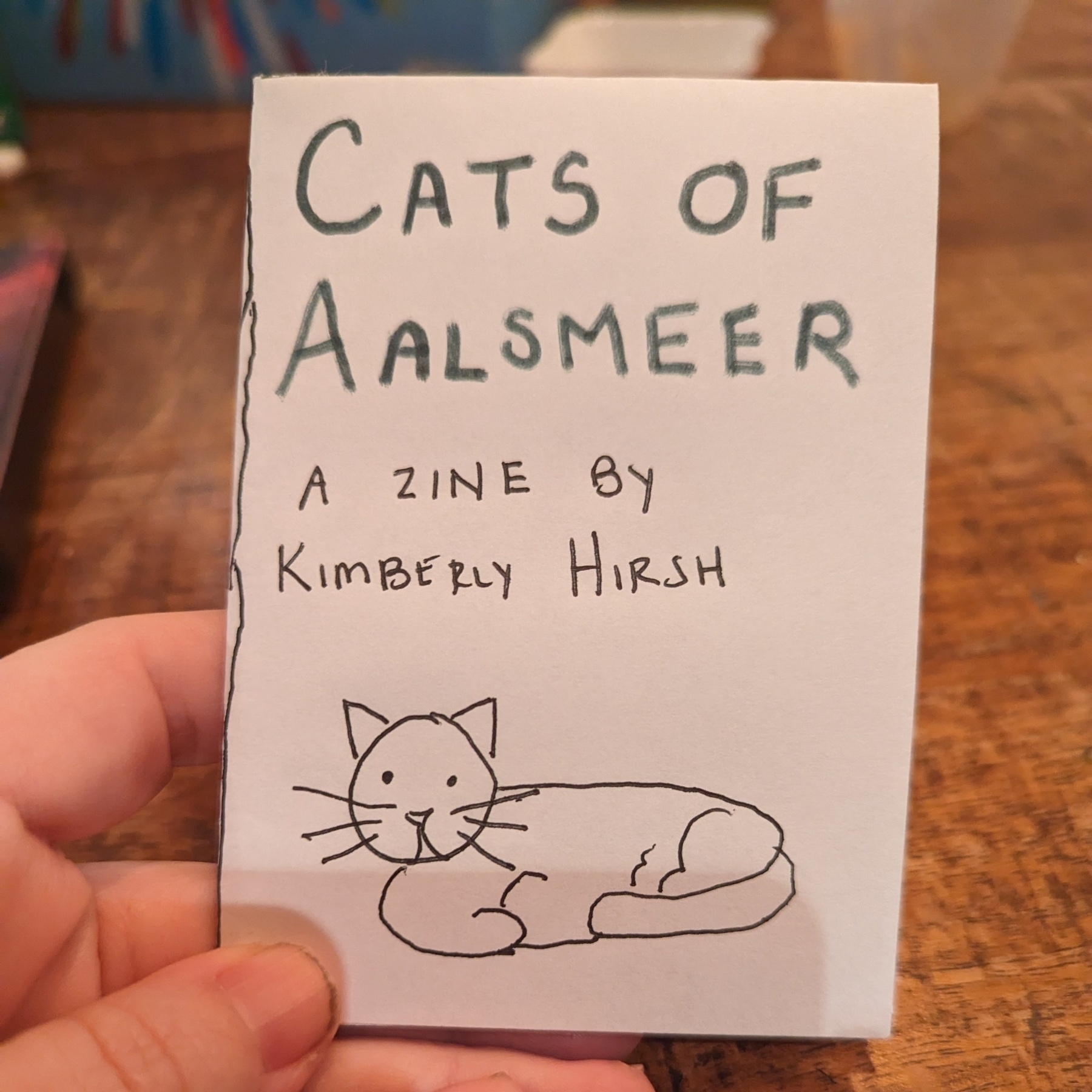
More about Amsterdam itself soon!
Where have I been?
I like Manton’s Where have I been post and have had a pretty significant change in where I’ve visited since the start of the year, so I thought I’d make my own list.
As for what counts:
If I simply passed through in a car, train, or bus, it doesn’t count. If I was only there at an airport for a layover, it doesn’t count.
Everything else counts.
7 Countries:
14 States:
Quand même
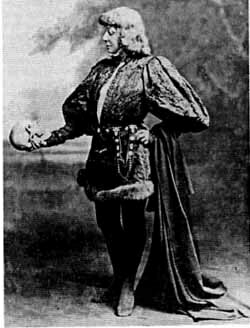
A while back I said I was going to get obsessed with Sarah Bernhardt (I seem to have said it somewhere other than my own website ☹️) but never followed through. But today I went to the Sarah Bernhardt exhibition at the Petit Palais and now I’m recommitting myself to this plan.
If you want to read about the exhibition, here are a couple articles:
Did you know Sarah Bernhardt was a goth multipotentialite? She acted, directed, sculpted, painted, wrote, ran a theatre, and led charity work. She had herself photographed in a coffin and was super into bats. And she was friends with Oscar Wilde. And she kept acting even after having her leg amputated and began her film career at age 56. I love her.
Content Warning: Suicide
There’s an AP news piece confirming what I suspected when I first saw Manton’s post about Heather Armstrong’s death.
Heather Armstrong, also known as dooce, was a prolific personal blogger, called “queen of the mommy bloggers,” a writer of books, a person who lived with depression and alcoholism. She was an early and high-profile example of someone who lost her job because of her blog. Her episode of The Hilarious World of Depression is one of my favorites. I didn’t read her blog consistently at all but I definitely read it both in some of its earliest days and in the past couple of years. She has been an influence on me without me even realizing it.
Armstrong leaves behind two children.
A little over sixteen years ago, my friend Sherrie died by suicide. It sent me into a big anxious spiral. Sherrie left behind a four-year-old son.
When my brother was a baby or toddler and I was fourteen or fifteen (and my sister was eight or nine), my mom had untreated hypothyroidism, pernicious anemia, and depression. She had suicidal ideations. She later told me that she didn’t act on them because my brother needed her. She believed my sister and I would have been fine.
We would not have been fine.
Even though I know that she was listening to the lies depression tells, I felt angry hearing that we were not enough to stay alive for.
Depression makes me so angry. Suicide makes me so angry.
I, too, live with depression. It’s usually in remission.
Every day, I choose to live. Most of all for my son, but also for myself, for the rest of the family. I think about how angry I am when I hear someone has died by suicide. I think about how I don’t want the people I love to feel that anger. I think about how I don’t want them to be angry at me.
I don’t have a strong conclusion for this post. Depression is bullshit and I wish nobody ever had to deal with it.
Response to Charlie Jane Anders's "What the Universal Translator Tells Us About Exploring Other Cultures"
🔖📝📚📺🍿 Read What the Universal Translator Tells Us About Exploring Other Cultures by Charlie Jane Anders (Happy Dancing newsletter).
Anders talks about the way a universal translator gives us shortcuts to understanding other cultures that don’t really show how hard it is to actually understand another culture.
She offers a lot of examples of this and asks,
How is it that Han Solo understands Chewbacca, but doesn’t speak Wookiee himself? And vice versa?
It’s been a long time since I was getting my Master of Arts in teaching and had to take a course on how Language Acquisition happens (almost 20 years), but I recall that we tend to understand much more of a language than we can speak, and I’ve certainly found that to be true recently.
For W’s Fulbright, we spent two months in the Netherlands, and had learned some very basic Dutch using Duolingo before heading over there. I often didn’t understand what people were saying, but I always understood more of what they were saying than I could ever speak myself.
Our first week there, some young people overheard my son saying his favorite Dutch word, “kat,” on the bus. They asked us about our being Americans and then one of them wanted to know if we were full of “kattenkwaad.” We didn’t know this word, and the person who asked didn’t know English well enough to explain it, but his friend tried.
I asked if it meant behaving like a cat, and he indicated not exactly. He tried to explain by example: pushing the stop button on the bus, then not getting off when the bus stopped.
“Oh, like, pranks!” I said.
“Yes, like pranks.”
“Mischievous,” my sister suggested. He wasn’t sure about that one.
Weeks later, I found this book in the shop a short walk from our house:
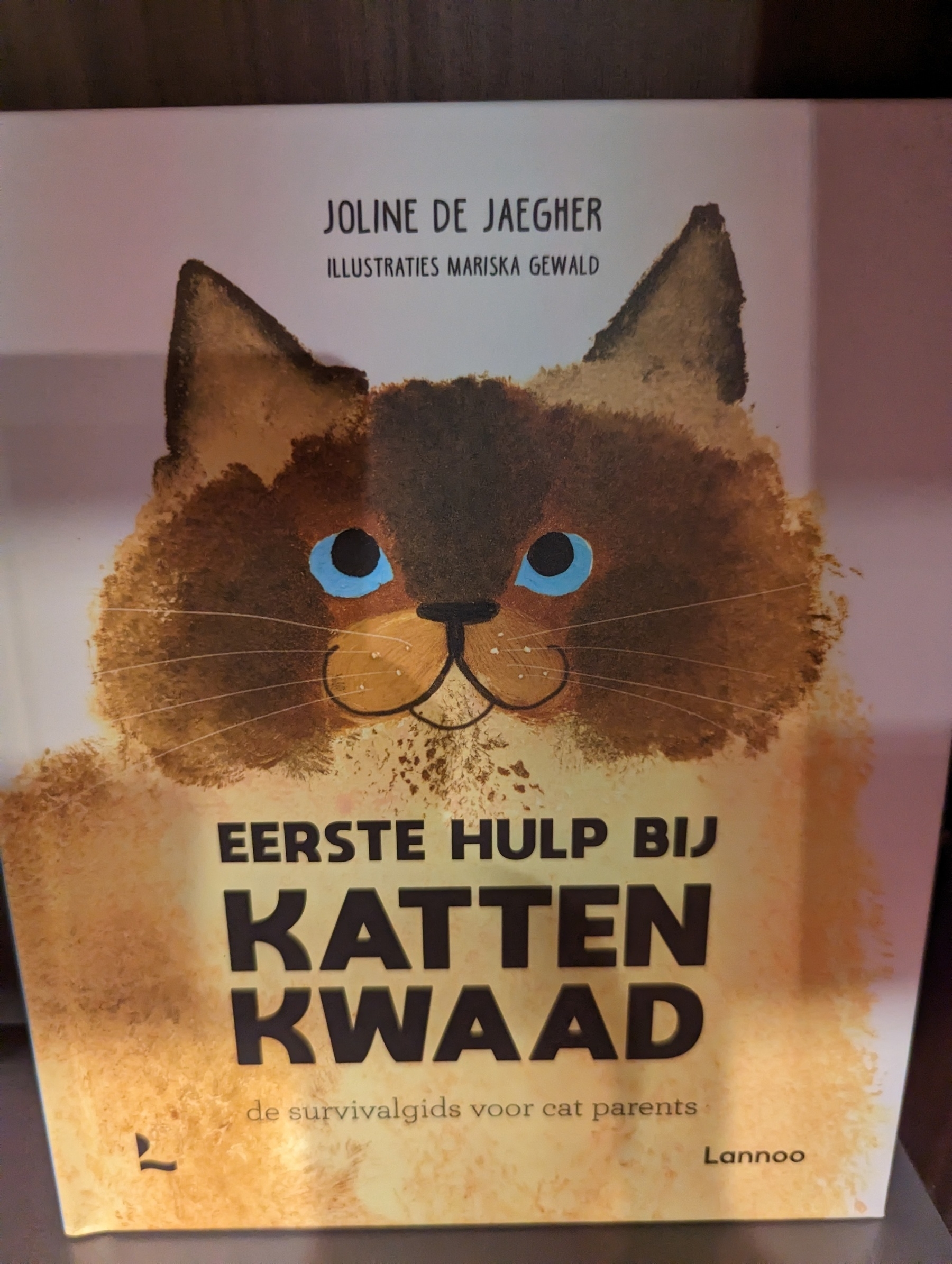
Google translates this title as “First Aid for Mischief: The Survival Guide for Cat Parents.”
I don’t think it captures the sense entirely, based on our bus conversation, but it’s hard to be sure.
It's over now, the music of the night.
I first encountered music from The Phantom of the Opera when I was 9 years old. I had taken a lip syncing class, because the Leon County, FL gifted program in 1990-91 was awesome, and at the performance where the most effective lip syncers gave a performance, a boy lip synced “Music of the Night,” complete with tux, cape, mask, and hat. (I was not selected for this performance, because the teacher said my performance of “Material Girl” showed that I cared more about the look than about lip syncing well, and she wasn’t wrong.)
I was immediately in love - with the song, with the costume, in my imagination with the lip syncing boy (who had been in a different class from me and who I hadn’t met nor would ever meet).
My mom promptly added the original cast recording to her next Columbia House order.
And the whole show was much bigger than that one song, endearing itself to me more than “Music of the Night” ever could have to me alone.
I stayed obsessed with the Phantom of the Opera. I read Gaston Leroux’s original novel. I read Susan Kay’s Phantom (highly recommend). I read The Phantom of Manhattan (fun but I recommend it not as highly). I went to see it when it came to Raleigh on tour. (1993, I think.) I played the computer game, Return of the Phantom.
When I met W in 1998, our mutual love of Phantom of the Opera was one of the things we first bonded over. That October, I hosted a costumed sing-along of it at my house. He was the Phantom and I was Christine. We did the same thing the following year.

We saw the show together when it came on tour. We saw it when they did a movie theater cast of the show in 2011.
Our son, M, has listened to the first act with me. We looked at The Complete Phantom of the Opera book together as we listened. He was very interested.
Next month, I hope to visit the Palais Garnier and see the places and things that I have only seen in pictures and my imagination so far: the grand staircase, the chandelier, box five.
The Phantom of the Opera has its last Broadway performance today. It’s been hugely important to me, even though I’ve never seen it there. I’m so glad it ran for so long. I know we haven’t seen the last of it in the US.
Turning My Dissertation into a Book in the Open
It’s been almost two years since I defended my doctoral dissertation. Before it was written, an editor had expressed interest in it. After it was written, I was very tired. I just couldn’t touch it. But we are in a critical moment for information literacy, and I think my research has some good contributions to make, so I’m going to start writing a book proposal.
For this project, I will be opening up my process and my reflections but not the content of the book proposal (and, if I get a contract, the book) itself. I’m starting by reading (like I always so). I’m going to read about how to turn a dissertation into a book and I’m also going to get myself up to speed on the FanLIS literature.
Won’t you join me?

Blogging as letters to our future selves
I blog for a lot of reasons. One of them is because blogging is a little like writing letters to your future self.
My current research contract (technically a postdoc) ends in early January. I constantly agonize over what to do next.
But it turns out past me knows what I want to do next. What both past and present me want to do is something I’m still figuring out how to turn into an income.
High Pain Day: Oh yeah, I'm disabled! I had forgotten.
I had my first high-pain day since we came to Europe yesterday (or today, if you’re in the US when I’m writing this).
I think I must have eaten something with cornmeal in it, because my joints and muscles were (and still are, though less so) sore from the moment I woke up.
It was a rough time to walk around Cologne in the cold and rain. I know I complained about the pain often, and I really appreciate my sister, her husband, and my friend Kessie having such patience with me.
We’re in Cologne for another day and I hope if I rest now, I’ll have a better time.
This is such a classic variable disability/chronic illness scenario. Sometimes you’re walking around Aalsmeer in 40 degree weather with no problems, and sometimes you ache with every step and even if you’re lying down. It’s easy to forget you’re disabled at all, until it isn’t.
The tricky thing is that you need rest, but if you’re in pain, it’s hard to sleep.
I'm a piler-filer. Who are you?
Austin Kleon blogs about pilers and filers, a dichotomy/spectrum he learned about reading Temple Grandin’s book, _Visual Thinking _, in which Grandin discusses Linda Silverman’s work:
In a presentation about the differences in learning styles, Silverman flashes a slide showing a person with a tidy file cabinet and a person surrounded by messy piles of paper. The “filer” and the “pilers,” to use her terms. You probably know which one you are. What does it say about the way you think?
Kleon says:
All of these “versus” type situations can be rethought as spectrums and/or creative tensions. There are times when I want to access that sequential part of my brain and bring order to things, and filing does that, but there are other times I want to access my visual brain, and piles help.
I am my father’s daughter, which means I’m a piler-filer.
Both my dad and I often have stacks that look like a mess to other people. But when I was a teacher, my colleagues marveled at my ability to run exactly what I needed from one of these piles within seconds.
I also had immaculate file cabinets full of things like student paperwork. I love a label maker.
For me and for my dad, piles are for current projects and files are for reference materials and archives. If something goes into a file before we’re done with it, it ceases to exist until an external event prompts us to track it down, by which point it may be too late for us to have done what we needed to do with it.
 .
.
This is a panorama of my desk when I was managing editor at LEARN NC. The stacks on the desk and in the standing file were projects in-progress. I filed finished projects in the drawers in the file cabinet/snack station on the left side of the desk.
So. We’re piler-filers. Are you one, the other, or a combination?
How a post ends up on my blog
Hi friends.
I wanted to take a moment to share my blogging “process,” which I put in scare quotes because it’s not very refined.
First, I have a thought or encounter something to which I have a response and decide I want to share that thought/response.
Then, I open up Google Docs and type what I want to share into a file called “Current Blog Post Draft.” I mainly do this to avoid losing a post because of a browser or app crash.
I sometimes read over it before posting. Sometimes I post right away.
My posts aren’t reviewed by an editor or even a beta reader. They go out fresh, raw, and often flawed in either form or content. The ideas are sometimes half-baked. I’m sometimes writing in the heat of emotion. I’m going to be wrong sometimes. Perhaps often.
Blogs are tools for thinking. As such, the thoughts expressed in them will not always be our most polished.
This is a personal blog, not a professional publication. I don’t mean for it to be anything but a personal blog and portfolio.
Thanks for reading it.
Quiet Time in Aalsmeer
Our second week in the Netherlands has been quiet so far. Exactly a week after we got here, I came down with a cough that has developed into a pretty standard respiratory virus. The COVID self-test was negative. This wasn’t a surprise because the rate of infection here is vanishingly small. Aalsmeer has about 32,000 inhabitants. One of them has tested positive this week.
Meanwhile in Amsterdam, 13 out of about 903,000 people reported positive tests last week.
For the purposes of comparison, that’s 1.2 cases per 100,000 people over 7 days. At home, there were 153 new cases per 100,000 people last week.
I know ground water numbers are more reliable but I struggle to interpret them, so this is what I use to determine risk.
So, it’s probably not COVID given the low incidence of COVID here and the negative test.
I’ve still felt pretty crappy, so I’ve been sleeping a ton. ME, M, and I ventured out to the Grote Poel (the large pool) of the Westeindeplassen. The humidity outside really helps my breathing but I have to be careful not to overexert myself.
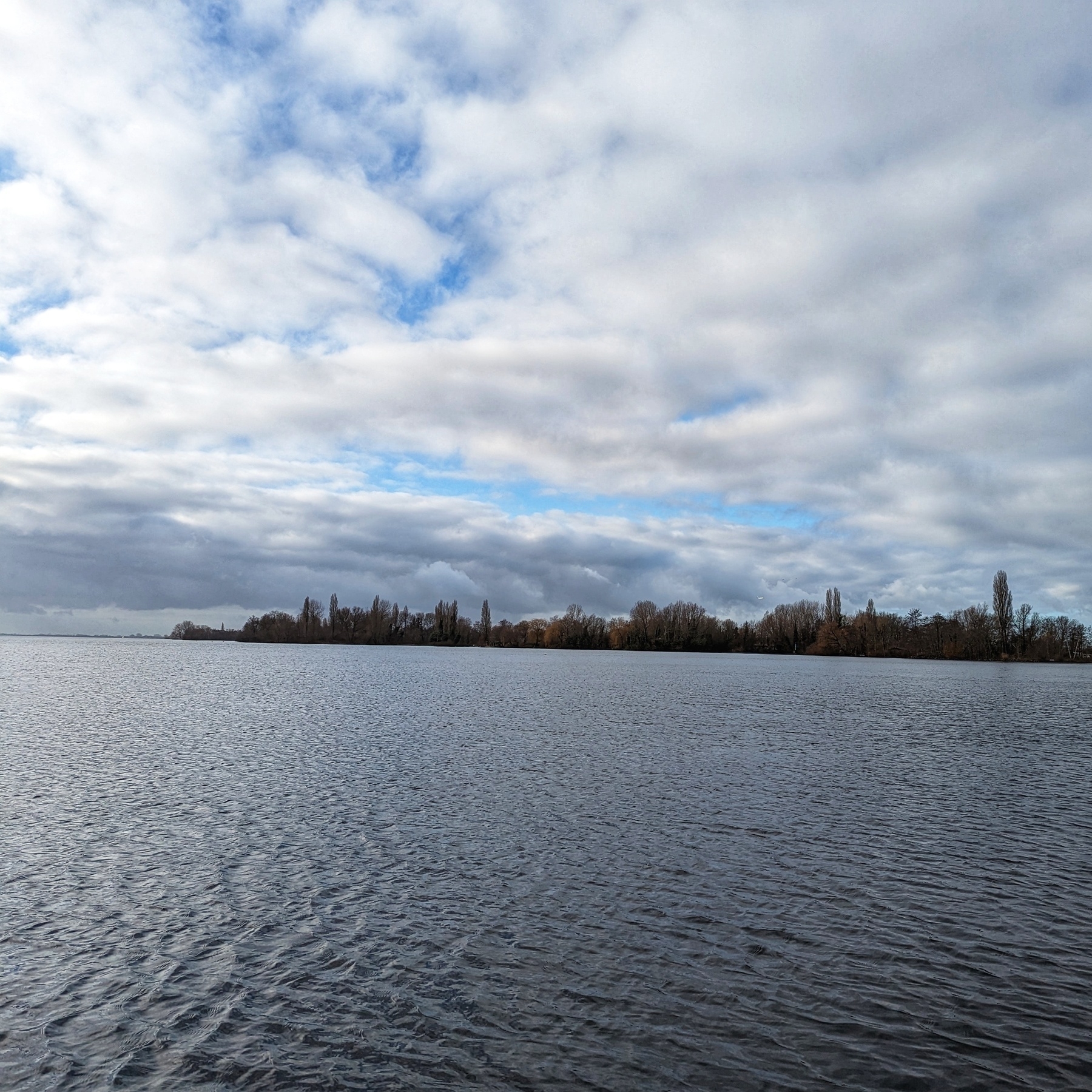
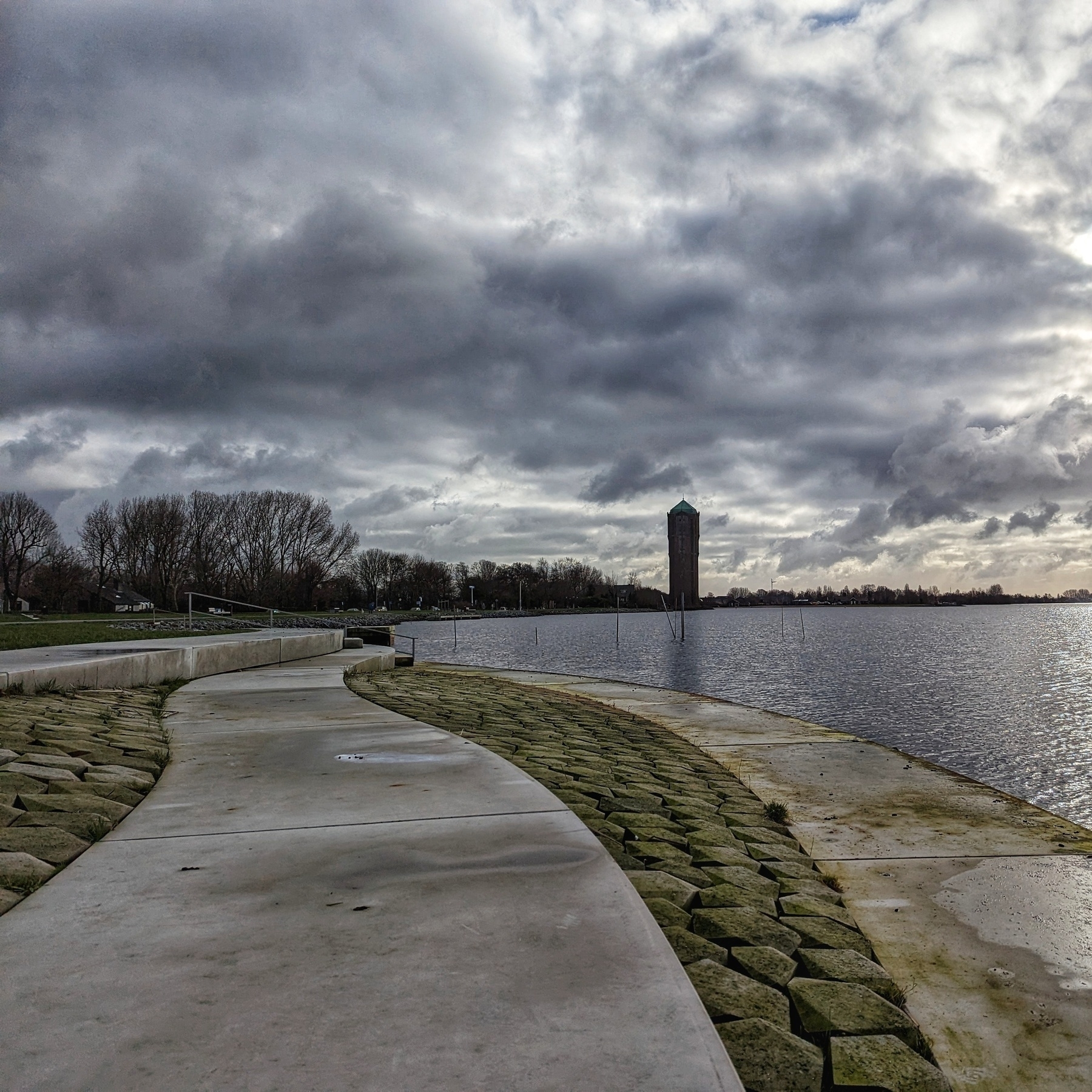
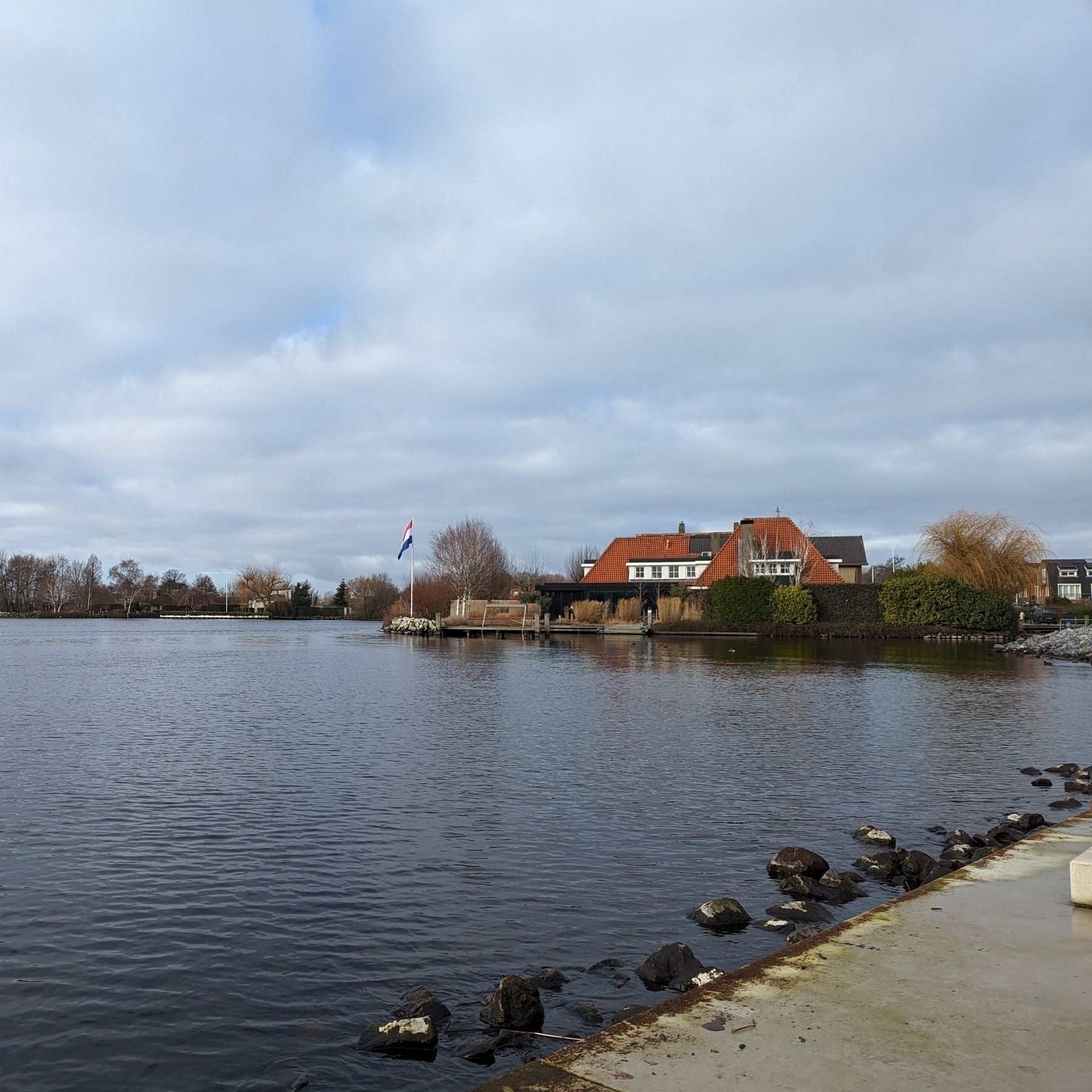
Today both ME & M are feeling poorly.
In the meantime, W has been into the city a couple times and loved exploring. I’m looking forward to getting the whole family there next week once we’re all back on our feet. It always takes at least an hour to get there from the village.
(When we booked the house, there was a bus that went directly to the airport train station but they changed the routes right before we came so it doesn’t run anymore. This adds one or two transfers to every trip.)
I guess people really want to know about what food you get when you travel. We mostly buy groceries and prepare our own food, so we haven’t tried anything extra Dutch besides stroopwaffels. Those are delicious.
The eggs here are super fresh and excellent. They have all the produce you might expect. They have a mix of Dutch brands and other brands. Froot Loops are Unicorn Froot Loops. We eat a lot of Nature Valley granola bars. There is, of course, immense variety in the cheese available.
That’s the latest here. I hope to be more adventurous soon!
Our first 60 hours in Europe
In case you missed it: my husband, W, received a Fulbright award to study European & transatlantic copyright harmonization, especially with respect to fair use/fair dealing. M and I are accompanying him. My sister ME is here as well serving as a mother’s helper for the first couple of months so I can actually do my job. (After she leaves, W and I will trade off childcare time.)
We’re currently based in Aalsmeer, a town closer to Amsterdam than Chapel Hill is to Durham. (That distance means more to people from our hometown than it will to other people but I thought it might be a useful comparison.) The University of Amsterdam is Will’s Fulbright host. He’ll interview scholars there as well as in Maastricht.
Because his award is specifically a Fulbright-Schuman award, his research is international, so we’ll also be visiting Helsinki and Rovaniemi in Finland, Bonn in Germany, and Brussels in Belgium.
In March, we’ll leave Aalsmeer and travel the UK and Ireland so he can interview scholars there. We’ll finish up in Paris and head home before Memorial Day.
…….
We left the US Monday evening and arrived in Amsterdam Tuesday morning, then road a train and a bus and walked about 600 meters to the house where we’re staying.
…….
I already love it here. Harbor cities always make me happy. I’m delighted by all the canals.
Also, the roads: buses have a completely separate set of lanes divided from the car lanes and so do bikes. Aalsmeer is a very walkable town.
…….
Yesterday we briefly went into Amsterdam proper for our appointment with immigration. UvA is used to international scholars sticking around, so they’re following all their normal processes with us including getting us set up with Dutch identification numbers and everything.
…….
Because we are using public transportation, it takes us about an hour to get into town. I already feel disappointed that we haven’t explored more but I have to remind myself that we haven’t even been here for 72 hours yet and I was in immense pain after the flights here.
…….
More to come. For now, have a picture from the chocolate shop near our house.
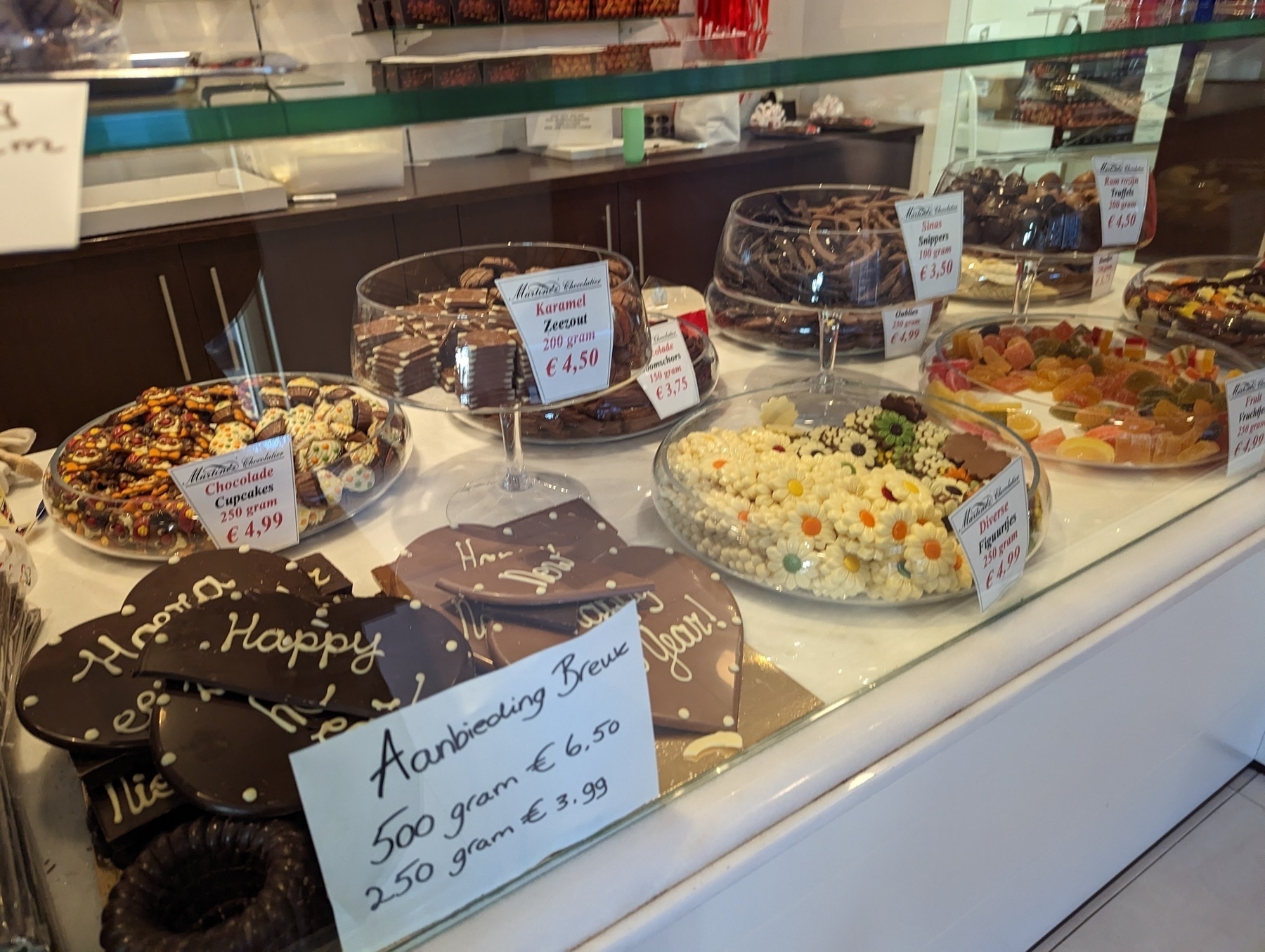
How I Begin
In Austin Kleon’s paid newsletter post today, he asked his readers, to share how we begin.
I opened by saying, “I don’t know how I begin.” Then I proceeded to describe how I begin.
Because the biggest projects in my life have been scholarly writing projects, I thought about those. I thought about the most recent one, my dissertation, and the oldest one, my Master’s paper.
I realized that for both of these, I had a sunshine-soaked AHA! moment when I knew: this was the topic I was going to write about, this was the research I was going to do.
But then I thought about it, and that wasn’t the beginning for the dissertation. (It may have been for the Master’s paper. I don’t remember.)
In my PhD program, writing a comprehensive literature review that demonstrated our familiarity with the state of our research area was a major milestone. I went into this process with no clear research question or idea, just a set of topics that interested me. I don’t remember all of them, but they included makerspaces in libraries, gaming in libraries, and connected learning, among other things. I wrote two or three chapters of this lit review (one for each topic), flailing about, no research plan in mind, just getting familiar with the literature.
But this flailing was part of my process! I arrived at my dissertation topic by reading someone else’s dissertation and deciding to answer one of the questions she posed as a possibility for future research!
And yet, I had read her dissertation before that sun-soaked day.
What was different upon this reading?
What was different was that I had been living the night before, not working. (Work is a part of life but you know how it’s easy to forget to do all the parts of life that aren’t work? Or at least to berate yourself for not focusing on work all the time? If you’ve ever been a grad student, you know what I’m talking about.)
The night before my sun-soaked AHA!, I had gone to a concert. A video game concert. Where I saw cosplayers who inspired me. And it was putting together the dissertation I read with the inspiration I felt at that concert that led me to my dissertation topic: how cosplayers find, evaluate, use, and share information.
So these are the ingredients in my process:
If I skip any of these three steps, I struggle to begin.
Tarot: My Year Ahead
I’m taking Lindsay Mack’s tarot class called The Threshold. Here’s my reading for the year ahead. Four major arcana - huge!
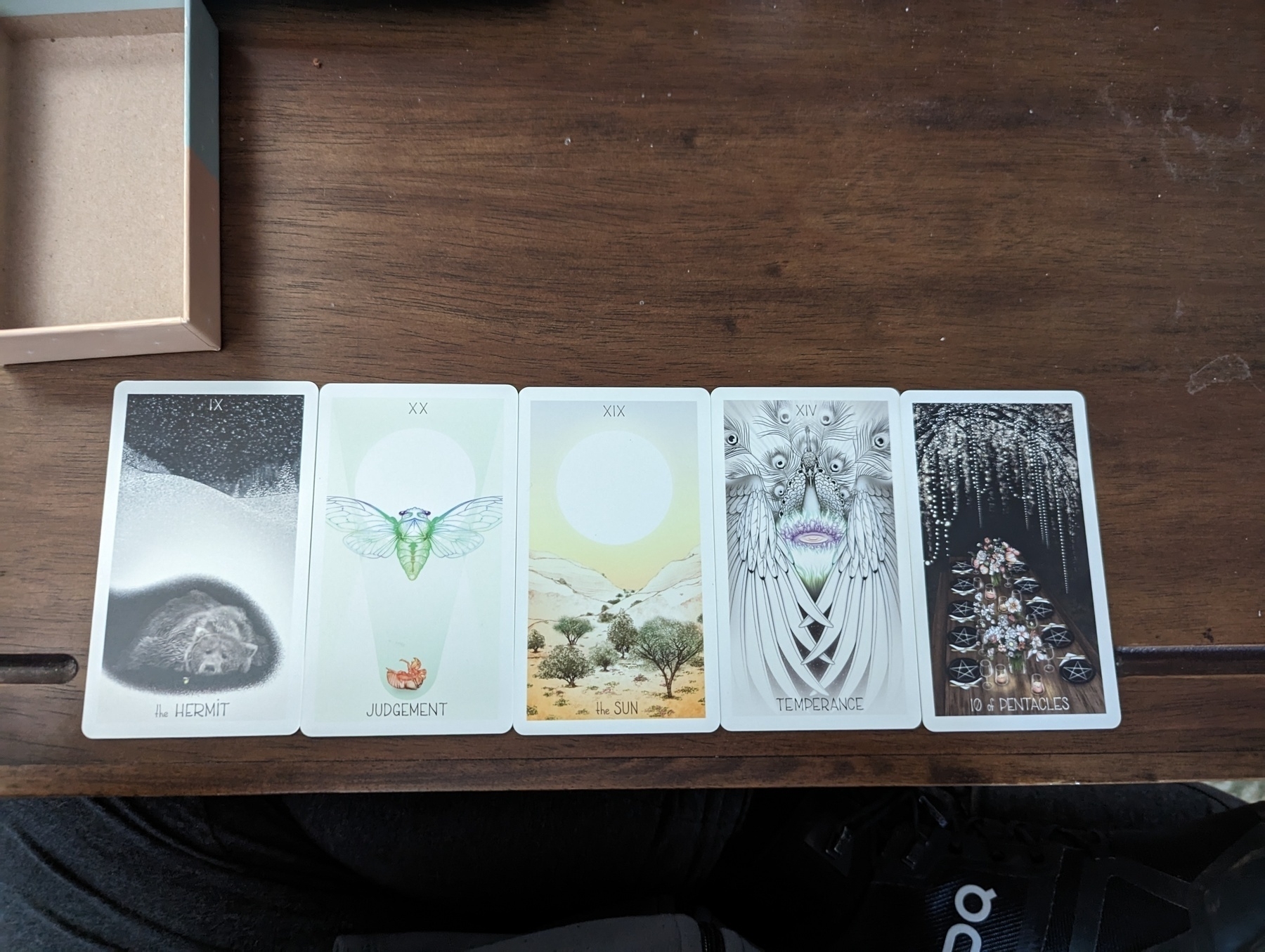
This whole spread fits with what’s going on with me. We leave for W’s Fulbright on Monday and hoping to do a lot of internal work while we’re away, vibing with the Hermit.
One of the things I’m struggling with is feeling a sense of purpose. I feel like Judgment combined with the Hermit gives me big “Show Yourself” (from Frozen 2) vibes - “You are the one you’ve been waiting for all of your life.” I have to look to myself for purpose. All the career quizzes and analysis of my 10th house in the world isn’t going to get me where listening to the quiet voice in myself will.
In being invited to give up the Sun, I see myself letting go of the need for bright, external, paternal clarity. It’s time to dwell in shadow for a while, to live in the murky and liminal.
With Temperance, I’m moving towards integration, integrity, my whole self being welcome in every part of my life. I think this will be key for the work I’m doing with the Hermit and Judgment.
And finally, the Ten of Pentacles: a reminder that I already have an abundant life, and that this abundance can carry me through the quiet and seeking.
Deck is the Wayhome Tarot.